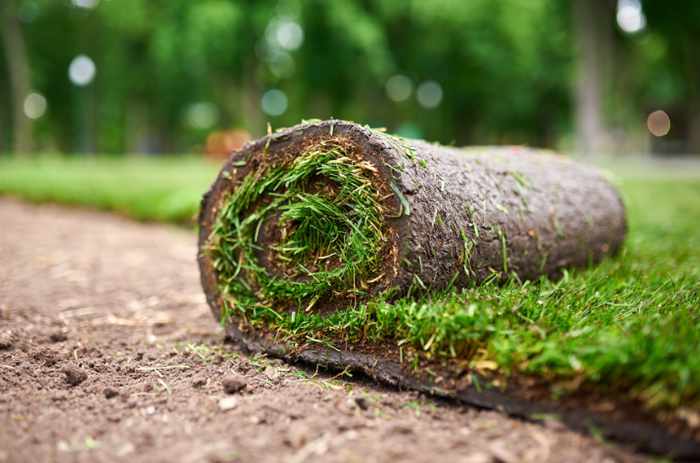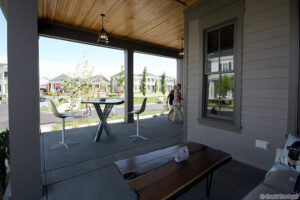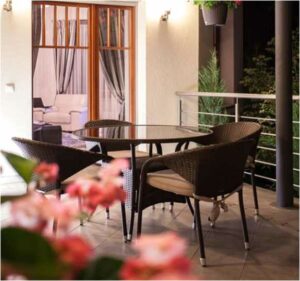Understanding the essential elements in this article is key to crafting beautiful outdoor spaces and unlocking the full potential of your home. A well-designed landscape is more than just a collection of plants and pathways. It’s an artful blend of natural and constructed elements that create a harmonious and functional outdoor environment. Achieving this balance requires a thoughtful combination of hardscaping and softscaping — two essential components that work together to enhance a property’s beauty, usability, and value.

4 Steps to Crafting Beautiful Outdoor Spaces
Just follow these four steps to build the amazing outdoor space you’ve always dreamed of. Whether you’re looking to upgrade your home’s curb appeal or are more focused on your backyard space, these concepts will help you move forward. Let’s go!
1. What Is Hardscaping and Why Does It Matter?
When you are crafting beautiful outdoor spaces is should always begin with hardscaping. You may be asking, “What’s hardscaping?” Well, hardscaping refers to the non-living elements in a landscape. This includes features like patios, retaining walls, pathways, stone walkways, decks, and even water features such as fountains. These components provide the backbone of an outdoor space.
One of the key benefits of hardscaping is its durability and low maintenance. Unlike living elements, hardscaped features require little upkeep and can withstand seasonal changes. They also play a functional role by providing practical solutions for sloped terrain, drainage management, and creating usable spaces for entertaining and relaxation.
From an aesthetic perspective, hardscaping offers endless opportunities to express creativity. Carefully chosen materials, textures, and shapes can transform a bland backyard into a stunning outdoor retreat. Incorporating elements like natural stone or modern concrete designs adds visual interest.
2. The Beauty and Purpose of Softscaping
Softscaping encompasses the living elements of a landscape, such as trees, shrubs, flowers, and grass. These elements bring vibrancy, movement, and seasonal beauty to an outdoor space. They also contribute to ecological balance by attracting pollinators, improving air quality, and providing shade.
The artistry of softscaping lies in creating thoughtful arrangements that achieve both visual appeal and functionality. A well-planned garden bed filled with colorful perennials can frame a patio beautifully, while strategically placed trees can provide privacy and cooling shade.
Beyond aesthetics, softscaping plays a vital role in sustainability. Choosing native plants, for instance, reduces water consumption and supports local wildlife. Properly designed green spaces can also help manage stormwater runoff and reduce erosion.
3. Blending Hardscaping and Softscaping
The true artistry of landscape design emerges when hardscaping and softscaping are seamlessly integrated. A beautifully crafted stone pathway winding through lush greenery exemplifies this harmonious balance. The contrast between structured, man-made elements and the organic forms of plants creates a dynamic outdoor environment.
Achieving this balance requires careful planning and design. The scale and proportion of hardscaped features should complement the surrounding softscape, not overpower it. Similarly, plant choices should enhance and soften the appearance of stone, wood, or concrete elements. Using climbing vines on a pergola or bordering a patio with ornamental grasses are just a few ways to achieve this integration.
Seasonal considerations are also important. Hardscaped elements remain constant year-round, while softscaping evolves with the seasons. Incorporating evergreen shrubs or winter-blooming plants ensures that the landscape remains attractive even in colder months.
4. The Value of Professional Expertise
Creating a cohesive and visually stunning landscape requires both artistic vision and technical expertise. Working with professionals can help property owners navigate the complexities of design, material selection, and plant care. Experts understand how to balance form and function while addressing practical concerns.
Enlisting services such as a professional tree service in Portland, or wherever local, can be invaluable for maintaining the integrity of softscape elements. Skilled arborists can ensure that trees are healthy, safely pruned, and integrated into the landscape without posing risks to structures or utilities.
By embracing the artistry of hardscaping and softscaping, property owners can transform ordinary landscapes into extraordinary environments. Whether through a tranquil garden path or a beautifully crafted patio, the possibilities are endless when creativity and craftsmanship come together. For more information, look over the infographic below.



